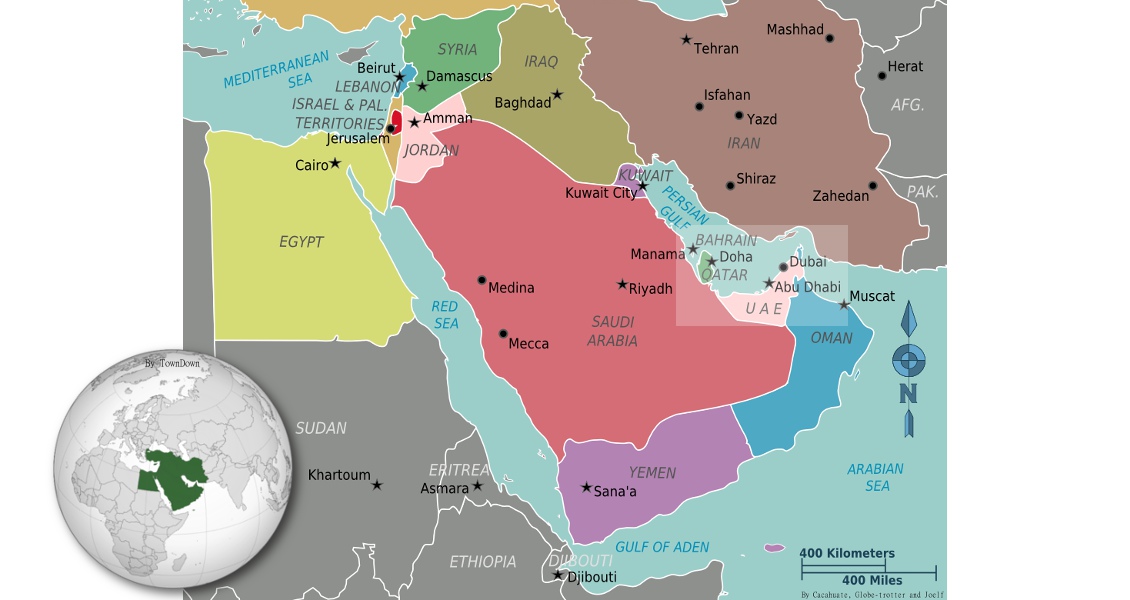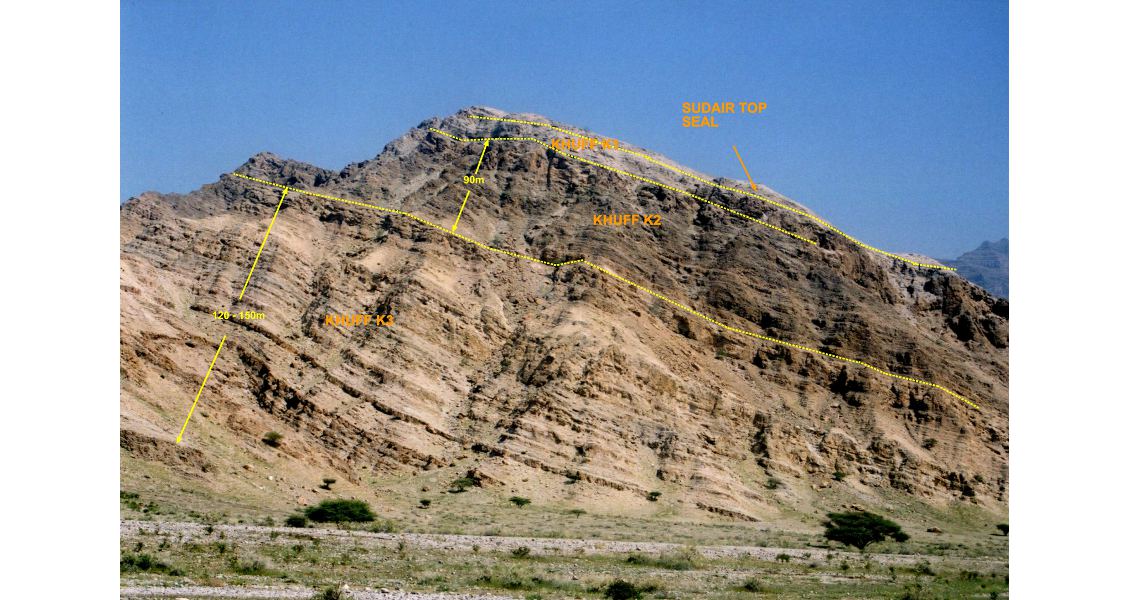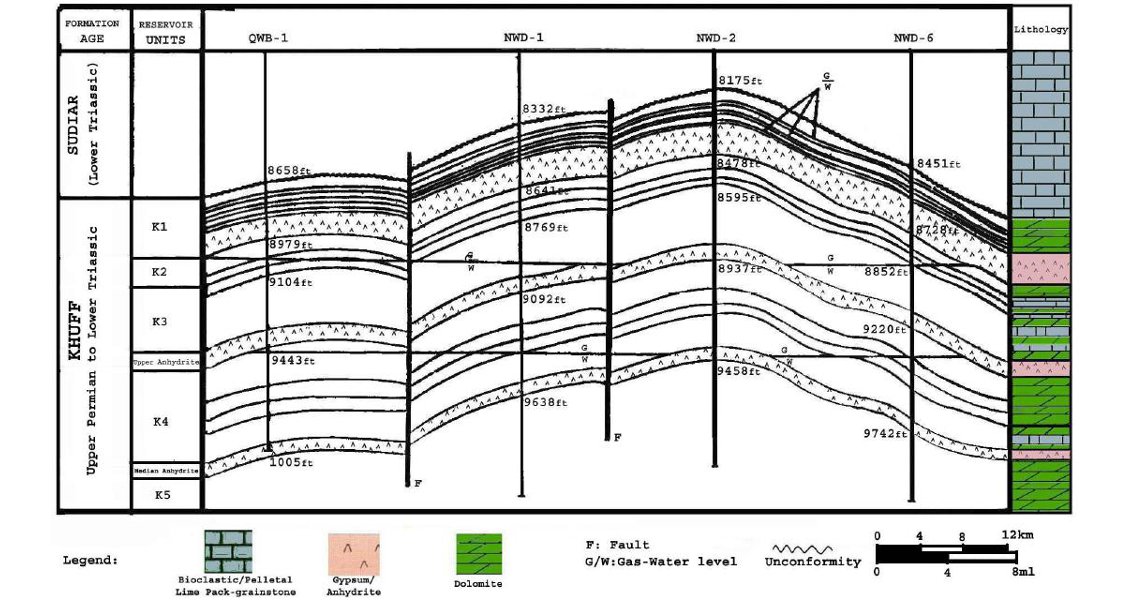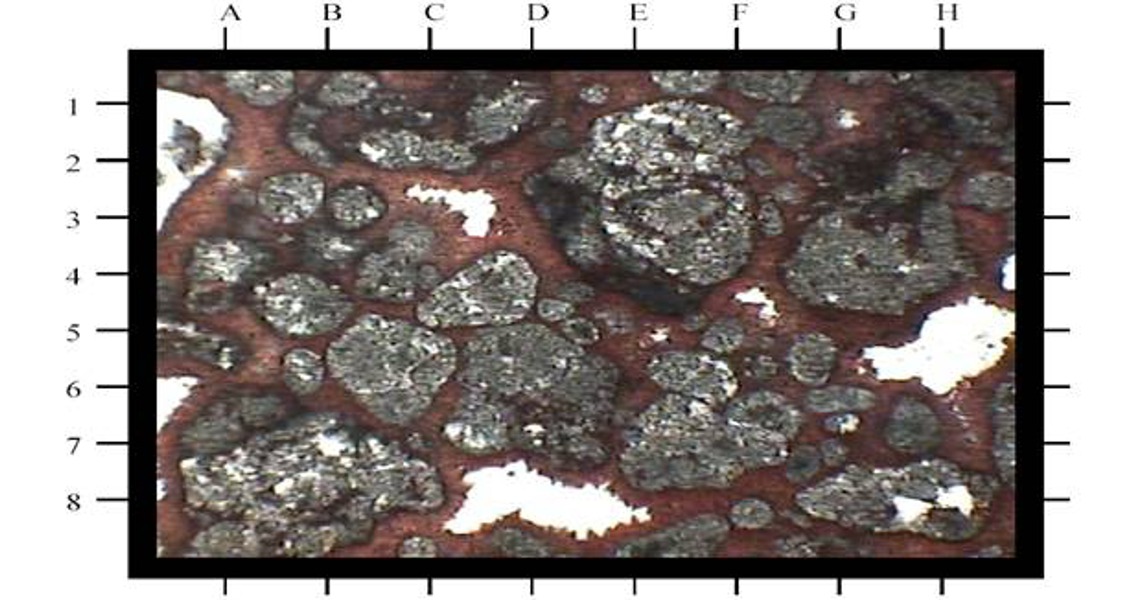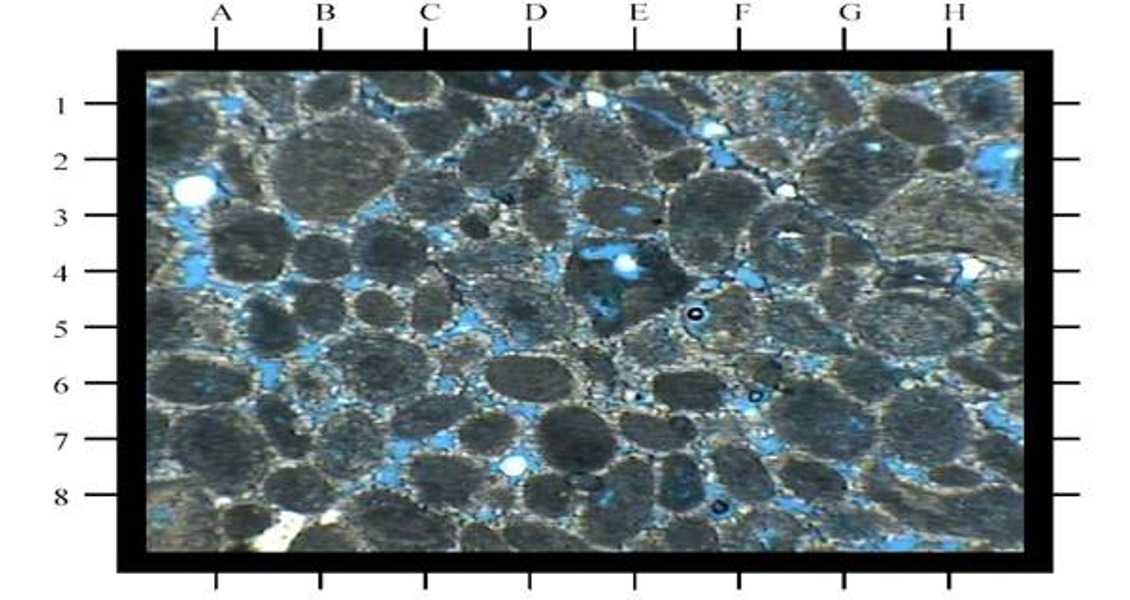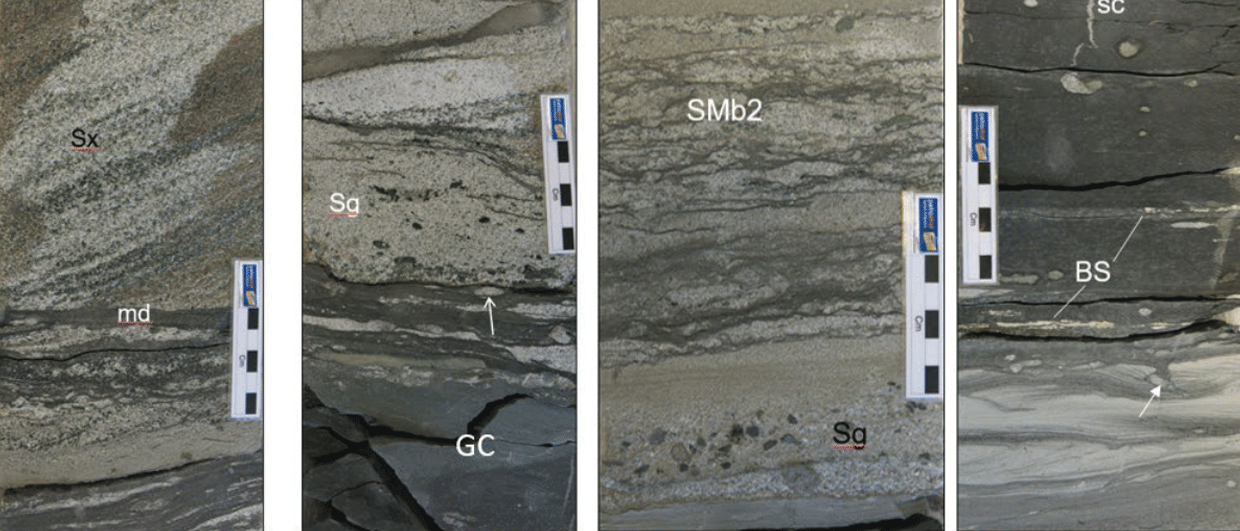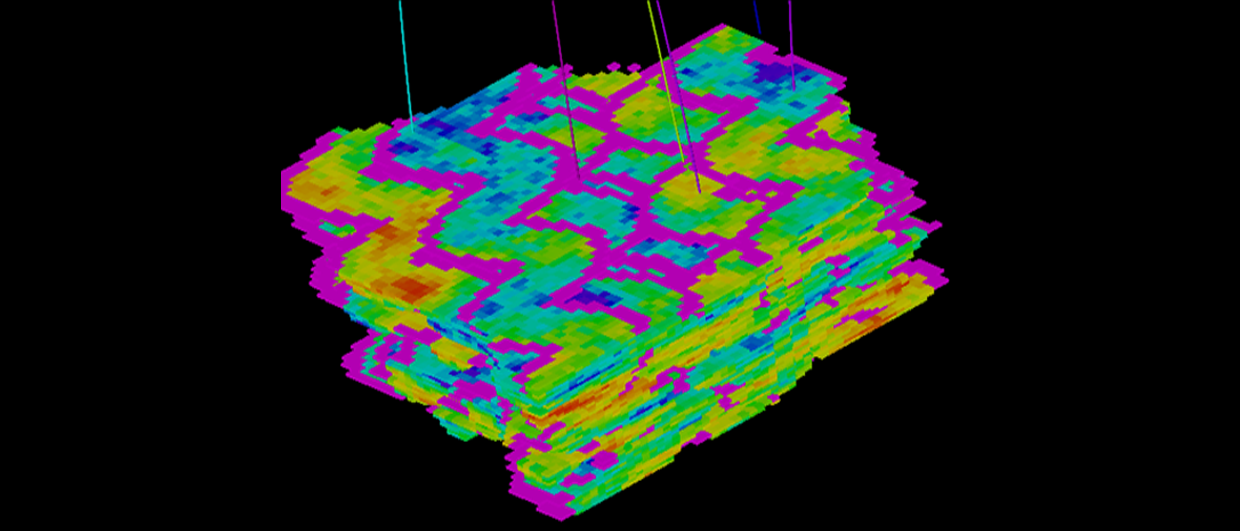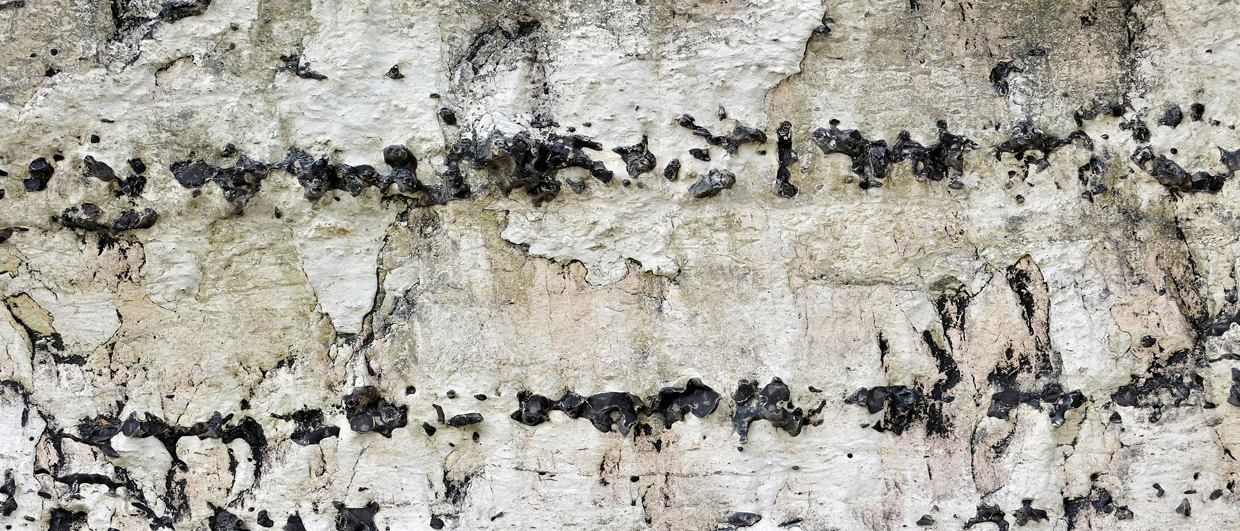For many years, Middle East explorationists have been fascinated by the Khuff Formation – as well they might. Several supergiant gas fields (defined as those with reserves of over 10 Tcf) have been found reservoired in this Permo-Triassic horizon in countries of the Persian Gulf, including Saudi Arabia, Bahrain, Qatar and Iran. Large onshore gas fields, such as Kangan, Dalan and Asaluyeh, have also been discovered in Khuff-equivalent strata in southern Iran.
Prolific Reservoir
Qatar’s North Field, with its Iranian extension South Pars, is the largest of all the giant fields producing from the Khuff Formation. The Qatari part alone covers an area of 6,000 sq km and has total recoverable reserves of nearly 1,000 Tcfg and a field life estimated to be in the region of around 200 years at planned production rates. Discovered in 1971, the North Field is the largest non-associated gas field in the world, making Qatar the third largest holder of gas reserves and the largest supplier of liquefied gas, shipping 38.5 Bcm (227 MMboe; 1.4 Tcfg) in 2007. The Iranian section, South Pars, has reserves estimated at 436 Tcfg. The total field area probably extends further to the east and south-east of the present production areas, so reserves and production figures are expected to increase.
With such extensive reserves and productivity, it is worth considering the factors which have resulted in the Khuff Formation being such a remarkably effective reservoir in this giant field.
Stratigraphic Evolution of the Khuff
The Khuff is made up of five cycles of carbonate-evaporite deposits and is probably one of the most complex carbonate reservoirs in the Middle East. This heterogeneity is considered to be the most significant geological uncertainty likely to affect sustainable field production performance and it is therefore very important that the factors affecting it are fully understood. The complexity is a result of changing sedimentary conditions and variations in diagenesis, with relatively high rates of deposition in environments oscillating between shallow intertidal and open marine. The formation was first deposited as a carbonate platform during the mid-Permian, but the climate gradually became warmer and more arid, resulting in the deposition of evaporates and dolomitisation of the carbonates.
The Khuff Formation rock types – limestone, dolomite, anhydrite and minor amounts of shale – are similar throughout the Persian Gulf. It is the lateral spread of the formation, coupled with subtle changes in rock features, which make it both productive and an interesting formation to study.
Khuff in the South Pars/North Field
The Upper Khuff carbonates in North Field/South Pars consist of five regressive megacycles. The oldest reservoir interval, K5, terminates in a 20m thick massive anhydrite layer, the Median Anhydrite, which has a considerable areal extend, sometimes replaced by a highly radioactive dolomite. The overlying megacycles each include a number of reservoir units.
The sequence consists of tight dolomites with occasional interbedded anhydrites, and four main thick units, known as K1 to K4, of usually undolomitized porous peloidal, bioclastic or oolitic carbonate. The lowest zone of the Upper Khuff, K4, is the most prolific, containing about 55% of the original in-place gas reserves in the North Field. This unit is the thickest and also the richest in terms of condensate concentration, with the lowest percentage of H2S. K2 is the most extensive of the four units in the North Field, and the K2 and K3 reservoirs contain about 37% of gas in place.
The Lower Khuff is sometimes subdivided into three reservoir units separated by three less porous units, with tight microcrystalline dolomite interbedded with occasional thin streaks of sucrosic dolomite. Thin anhydrite beds are sometimes found near the top.
Diagensis Increases Poroperm
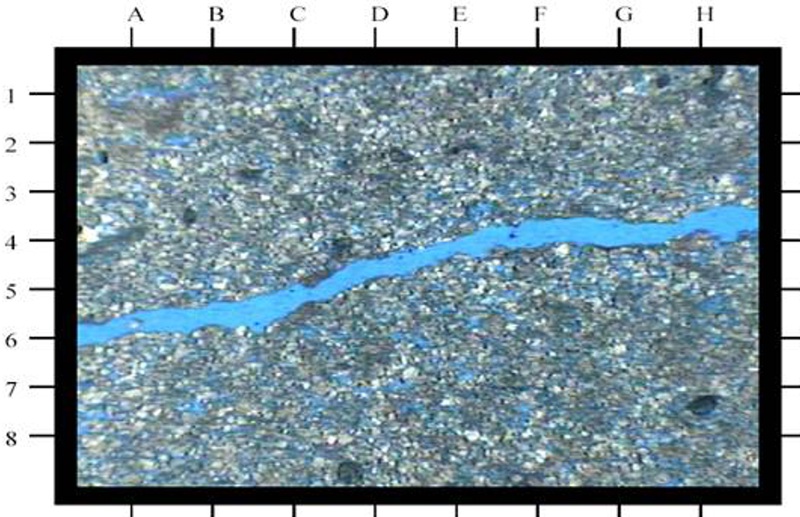 Fine to very fine grain peloidal dolograinstone with microfracture porosity (K2 zone).The productivity of the rock is primarily explained by diagenesis, or post-depositional changes, which resulted in high porosity and permeability, probably further enhanced by fracturing. Sometimes, as in the Ghawar Field in Saudi Arabia, diagenesis reduces poroperm in the Khuff reservoir by filling the pores with anhydrite.
Fine to very fine grain peloidal dolograinstone with microfracture porosity (K2 zone).The productivity of the rock is primarily explained by diagenesis, or post-depositional changes, which resulted in high porosity and permeability, probably further enhanced by fracturing. Sometimes, as in the Ghawar Field in Saudi Arabia, diagenesis reduces poroperm in the Khuff reservoir by filling the pores with anhydrite.
Petrographic study of the Khuff reservoir indicates that the rock has undergone many diagenetic changes. For example, during deposition much of the Khuff was made up of calcium carbonate in the form aragonite, but on burial this tends to alter to the more stable calcite. Some aragonite leached out soon after deposition, as did some oolitic particles, creating pores which are isolated from the usual intergranular pore system.
The Khuff reservoir has also undergone dolomitisation over time, which, if accompanied by the leaching of calcite, can result in more porous and permeable reservoir rock. If this leaching occurs after a continuous network of dolomite crystals has been formed, then the reservoir quality is determined by the size of the dolomite crystals and intervening pores; the larger the crystals, the higher the permeability and the lower the water saturation.
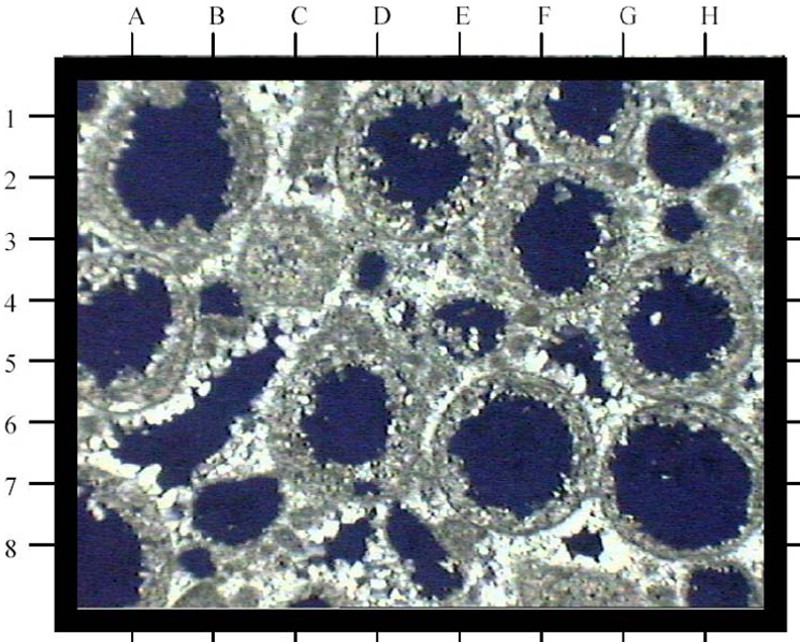 Ooid grainstone with interparticle (B6, D8) porositiy (K1 Zone).In the Khuff Formation the highest porosity with the best interconnected pore systems is found in the grainstone (a mud-free limestone) and packstone (limestone with a mud matrix) reservoir intervals. Some interparticular pores are found to be totally cemented with either anhydrite, dolomite, or calcite, which lowers the rock permeability and recovery efficiency, although the resultant anhydritic dolomite forms an excellent intraformational seal.
Ooid grainstone with interparticle (B6, D8) porositiy (K1 Zone).In the Khuff Formation the highest porosity with the best interconnected pore systems is found in the grainstone (a mud-free limestone) and packstone (limestone with a mud matrix) reservoir intervals. Some interparticular pores are found to be totally cemented with either anhydrite, dolomite, or calcite, which lowers the rock permeability and recovery efficiency, although the resultant anhydritic dolomite forms an excellent intraformational seal.
A study of porosity, permeability, grain density and pore size value from the four main producing zones of the Khuff Formation in South Pars revealed that zones with good porosity and permeability are not uniformly distributed. Interconnected pore systems offer the highest values of permeability, sometimes exceeding 1,000 mD. High porosity does not, however, always lead to the best reservoir rocks. Some of the highest porosity values are found in the shoal deposits in the youngest rocks of the Khuff Formation, but much of this porosity is comprised of pores which, due to diagenesis, are not effectively connected. As a result, despite their high porosity, these rocks do not make good reservoirs, as their permeabilities are generally low.
Porosity Not the Only Answer
Fractures, concentrated in the lower porosity intervals of the Khuff Formation, have been found to be of significance to productivity, although they can be difficult to evaluate because the low porosity horizons are not generally cored. While core examination is an excellent way to evaluate fracture density and mineralisation, it is difficult to recover good cores from highly fractured intervals. Moreover, as the Khuff is often very thick – over 800m in the South Pars/North Field area – the entire formation is rarely examined through coring.
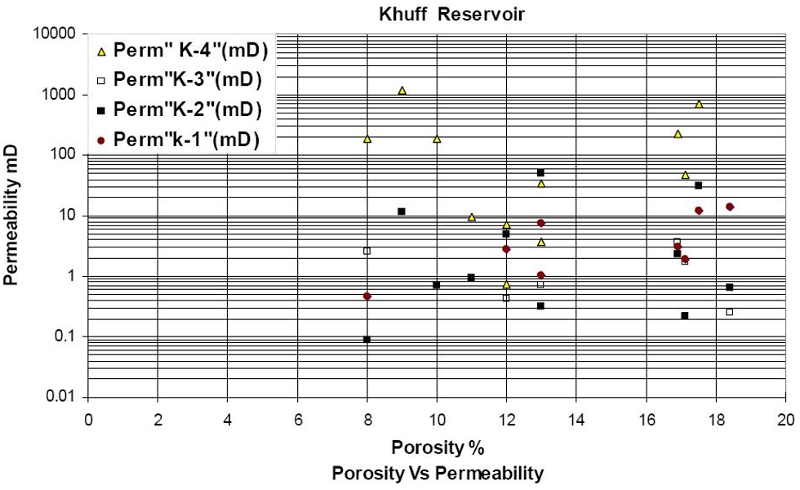 Porosities Vs Pemeabilities for different zones within Khuff formation.In conclusion, both the depositional environment and the diagenesis of the sediments appear to have had an equally important role in creating the exceptional efficiency of the Khuff Formation as a reservoir rock in the South Pars/North Field area. Porosity and permeability are frequently very high, often enhanced by fracturing, and the packstones and grainstones, commonly found throughout the wide extent of the formation, form the best reservoirs. Massive anhydrite and anhydritic dolomite is associated with low permeability and forms excellent seals for Khuff reservoirs.
Porosities Vs Pemeabilities for different zones within Khuff formation.In conclusion, both the depositional environment and the diagenesis of the sediments appear to have had an equally important role in creating the exceptional efficiency of the Khuff Formation as a reservoir rock in the South Pars/North Field area. Porosity and permeability are frequently very high, often enhanced by fracturing, and the packstones and grainstones, commonly found throughout the wide extent of the formation, form the best reservoirs. Massive anhydrite and anhydritic dolomite is associated with low permeability and forms excellent seals for Khuff reservoirs.
However, the formation is widely distributed in the Persian Gulf area, and reservoir quality varies both vertically and laterally, so porous zones are not uniformly distributed. Depth of burial is thought to be a significant factor in productivity, and not all Khuff fields are as shallow as North Dome. Porosities are commonly quite poor – typically less than 10% – in more deeply buried structures, yet flow rates can still be economic at burial depths in excess of 5km, so porosity alone does not explain the productivity of the formation.
In addition, porosity due to diagenesis means that the sediment must have been preserved for over 250 million years, and raises questions as to what causes the preservation of this feature over such an unusually long time. Shallow burial depths across long-lived basement highs, and arrested diagenesis due to early charging from source kitchens in adjacent lows, may have a part to play in this.
It would appear that porosity and permeability due to diagenesis are the most crucial factors leading to the productivity of the Khuff in the South Pars/North Qatar Field, but there are still a number of questions to be answered, especially when addressing these features of the formation elsewhere in the region.


